_________________________________________________________________________________________
For more about me, click on the image
Ponzi Scheme of Madoff
A monument that show you the decline of Rome: the arch of Constantine
Probably the best preserved arch of Ancient Rome. The arch commemorates the victory of Constantine over Maxentius at the Battle of Milvian Bridge in AD 312 for sole control of the Roman empire in the west. His problems with Maxentius started when Maxentius built a Basilica. (open the pop-up about the concept Basilica to understand why). He became to popolar and as so much a rival of the emperor Constantine. The famous battle at the Milvio Bridge on the 28th of October 308 D.C. at the Tiber-river made an end at his life. A few years later Constantine, who won that battle under the sign of the Cross, approved Christianity among the other religions with the Edict of Milan of the year 313. He built also the four large basilica's of Rome: Two outside the walls: Saint Peter and Saint Paul outside the Walls; two inside the walls: Santa Croce in Jerusalem and Saint John in Lateran. The latter became the official residence of the pope (until today it is the Mater Ecclesiae, the most important church in Christianity, being there the pope the head of the Holy See, the spiritual director of the Catholic Church).
Strangly enough, Constantine, after all the good he did for the Catholic Church, never became a saint. But, yeah, we have to admitt that he also killed over 60 000 of his friends. For fear of his life he moved away from Rome to the East, where he built a new capital, called after himself: Constantinople. But of course, that was the start of the final blow in the decline of Rome. If in the Ponzi-Scheme of Mister Madoff, he is going off-shore, the money is follow him. And so, by building Constantinople, all the money was directed to that city. Less than 140 years later in 476 A.D., Rome came to an end, not having any money anymore to defend itself. But so much money went to Constantinople that they could sing it out for an other 1000 years. Constantinople managed to survive untile the 29th of May 1453, when finally it was sacked by the saraceens.
And the arch of Constantine shows you that decline.
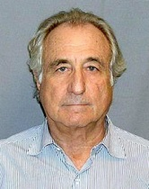
Madoff, no comment
And they are working, and working!! Rome finally decided to have a third subway, “Linea C”; differs from the first two lines, because it will not reach the borders of the city, but going through its heart. It will cross the Vatican, the Chiesa Nuova on the Corso Vittorio Emanuele II, the Piazza Venezia and the Colosseum. You can imagine yourself what kind of problems are raising. Going through the centre!!! And as soon you start digging, there are archeological remains everywhere. They say it will become the most beautiful subway in the world, exposing in its different stations the artifacts they found. And luckely they know what is there thanks to the Forma Urbis, marble plates with the first google-map of the history. Every building that existed in the year 206 is marked on it. In the Museum of the Civilità Romana you can view it, like it was found backe under the Mussolini-era.
And so, they are working on the Piazza Venezia, where our tour starts of the “Fori Imperiali”, the forums of the Emperors. Aside of the Memorial of Vittorio Emanuele II, the first king of Italy, lays the Forum of the Emperor Trajan:You can recognize it immediately: a hugh column stays in the centre of it. The enormous road that leads to the Colosseum was made by Benito Mussolini in the twenties, when he needed his army as audience for his speeches from the balcony of Palazzo Venezia. This palace was the former residence for the ambassadors of the doges in Venice, than became the Embassy for the Austrian-Hungarian Empire and later the seat for Mussolini’s government. Today it’s a museum. From the Via Fori Imperiali, the government removed in the last ten years the lateral parts from what was once the largest road in Rome. Luckily, Mussolini didn’t destroy what was underneath, he just covered it. Archeologists from all over the world are working there frenetically today and tunnels will in the future connect the two parts, just like it was once upon a time. And where will be the entrance of the C-line of the Metro, at the building of the “Assicurazioni Generali”, they found the “Academy of Adrian”. To understand all what was build here in the the time of the Caesars, we should start by explaining the concept of privatization in the roman world.
On one side of the Via Fori Imperiali we have the forum of Julius Caesar, and the Forum Romanum, the political heart of the Roman Empire with it’s Curia and Rostrum; on the other side is the Forum of Trajan, his market, the forum of Augustus and the forum of Nerva. Most of those “fora” became visible through the archeological work of the family Spada in the seventeenth century, and the facade of their palace in the centre of Rome evokes it. Mussolini, gently enough, placed in front of each forum a bronze statue, representing the different emperors, as mark stones “Who is Who”. Wasn’t he after all not the last successor in a long line of Emperors? And, as we already know, the history is written by the victor, Mussolini dated them, starting counting history with his access to the power in 1922. The basement of each statue has the name of the emperor, and underneath A.F. XI : in the year of the fascists 11, that means it was put there in 1933.
The same happened in the Roman empire. You want to become Emperor?
Do fundraising. Let us say you needed 400 million denarii or sesterces for your campaign. After winning the elections (for the emperor the goodwill of the pretorian guards who made you emperor), you have to please your investors and shareholders, (Big electors ??) with interest. So, once emperor, your are selling the function of governor on the auction. And say the auctions starts at 20 million denarii. Someone offered 25 million, a third one 30 million and so on. Let say the last bid was 40 million. And when the hammer came down, he won the auction. In a similar way Herodes Atticus became the governor of Greece, being one of the wealthiest of his time. And what he has to do ? ... simply enough: fundraising. He had to find 40 million denarii and to pay it in Rome before leaving to his province. Twenty governors at 40 million, made 800 million for the emperor, who got his money back with interest. As a governor in Greece he had to make his lost good. At least, there he could rule as semi-king. A small part of what the province produced was for Rome, the rest (including the looting) for himself and his shareholders. But you can imagine him thinking that he was that stupid to indulge himself to pay so much money, while the auction only started at 20 million denarii. This didn’t change his composure and sleep. Arriving in the province, he looked for 200 tax-collectors, starting the auction at 200 000 denarii each. And .... the money came back with interest. If the taxcollector couldn’t find his money back, that isn’t the problem of the governor. If the governor can’t find his money back, that isn’t a problem for the emperor. Taxes were paid in advance. This is also the reason that in the gospels the tax-collector Zacheus/Mattheus is not loved by the people. As tax-collector he wanted his investment back, and with interest. When Jesus told him to give back what he stole, he replied: “I have no idea what I took!”, on which Jesus replied: “Seven times seven” or 49 %. Was that the amount he added? probably yes. It seems to me it was a lucrative job in the Roman Empire to buy your job. But even today: those who are entering in politics are doing it for saving the country, isn’t it? And look at the scandals of the U.K. parliament. Ponds got cleaned by the taxpayer money, a second house and mortgage in the capital, ... again the taxpayer. But isn’t the roman system not genius? Taxes are paid in advance. The government doesn’t have to run behind unwillingly taxpayers! It also created the welfare-state of Rome. Roman citizens didn’t have to pay taxes. The rest of the world did it for them. Rome was really a tax heaven, just like Luxembourg, Liechtenstein and Monaco or the off-shore Islands of Jersey today. Bernard Madoff, the banker of the Ponzi-scheme would like Rome very much indeed. The lowest levels paid the top. And as long you are creating new territory and provinces, you get away with it. The problem arrived when the system started shrinking, and brought it to it’s decline. It also explains that what you will see in Rome, you will also find in the province, ... only in Rome it’s bigger. Copies of the Colosseum, baths, temples etc., but smaller. Herodes Atticus built an amphitheater at the foot of the Acropolis in Athens, the Odeon, still in use today. It was used for the opening-ceremony of the last Olympic Games in Greece. It’s identical to what was built in Rome, just smaller. Of course, in the Ponzi-scheme, the biggest fundraiser is sitting in Rome. He only built an amphitheater on the scale of a governor and not on the scale of an emperor. The same, but much smaller again, for max. 3000 people, you will find in smaller cities, because only built with the budget of the major. Cicero was governor in Spain for one term only. He was known as a good, rightful and honest governor. That’s what you call in Rome a stupid one! Your task as governor is not being good or honest, but to loot as much as possible in the shortest time and paying your sponsors back with interest! It seems to me indeed that the privatization of public offices was part of the growth of Rome ... and as we will see later, it’s decline when the system started shrinking.
What was the function of those “fora” dedicated to the various rulers? Especially when you have “the Forum” next to it. Privatization meant in the empire, and shortly before, that every job is for sale on the auction. In a certain way, the main function of those areas dedicated to emperors was for fundraising. You want to become emperor, or just succeed your father as emperor? Nothing as easy as that: do fundraising. That became day after day more important after the reform of the Gracchi Brothers. Actually, there is no big difference between the roman system and the today election of a president of the USA. Obama won over his rivals by outspending them, and forced poor Hillary Clinton to use her good money in Clinton-states. And there was no money anymore left for her to campaign in the swing-states, let alone in republican states. McCain on his turn was lost over the question of public funding or not. When it for Obama became clear that he could raise more money with private funding, he abolished the idea of public funding. More about that in the The Vatican Museum. But what Obama put in the mind of people was the idea that someone who hardly can run a smooth campaign, wouldn’t be able to run the biggest economy in the world.
What were the jobs for sale in the empire?
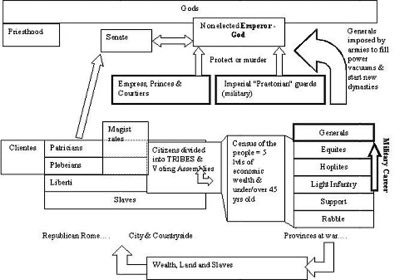
Jobs obtained by elections during republic
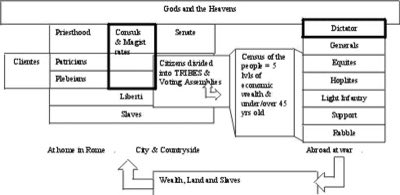
The man that cancelled the Republic: Julius Caesar
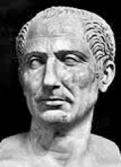
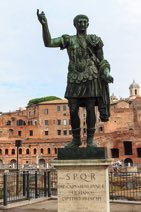
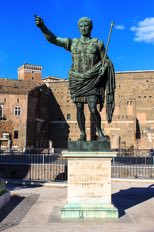
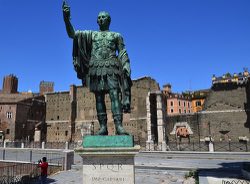
Jullius Caesar
Octavianus Augustus
Nerva
